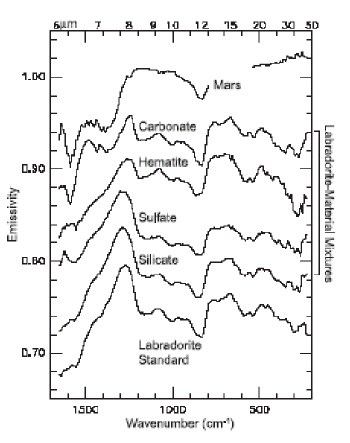Small amounts of carbonate minerals have been discovered on the surface of Mars for the first time. The result could help researchers better understand the history and evolution of the planet as part of their efforts to determine if the conditions for sustaining life ever existed there. Joshua Bandfield and colleagues at Arizona State University discovered that particles on the surface of Mars reflect and absorb infrared radiation in a way that exactly matches that of magnesium-rich carbonates found on Earth (J Bandfield et al. 2003 Science 301 1084).

Carbonates naturally form in the presence of carbon dioxide and liquid water, and could therefore provide important evidence for the presence of liquid water – and possibly life – in the Martian past. Although researchers have already detected carbonates in some meteorites from Mars, they have never yet found them on the surface of the planet.
Bandfield and co-workers used the Thermal Emission Spectrometer (TES) on board the Mars Global Surveyor to measure the spectra in different areas of the Martian surface at varying angles. This technique allows the researchers to analyze a single region through different amounts of atmosphere, and so separate surface and atmospheric contributions to the spectra. The Arizona team found an anomaly in the spectra near a wavelength of 7 microns, which they compared with spectra taken from various Earth minerals. Only mixtures containing carbonates matched the Martian spectra (see graph).
The team also observed that the carbonates were widely distributed in the surface dust with no indication of a concentrated source – such as limestone in basins. “This implies that large bodies of water were not common in Mars’ past,” Bandfield told PhysicsWeb. “It confirms an emerging paradigm: that the planet may never have had a significant warm and wet epoch.” The carbonates can also store significant amounts of carbon dioxide. “This may have been an important sink for a past, thicker carbon dioxide atmosphere that is now locked up in rocks,” added Bandfield.
The group now hopes to completely characterize the minerals they found. It also plans to take more precise measurements with the mini-TES instruments on NASA’s Mars Exploration Rovers.




